|
Research begins with a question; in genealogy, this question concerns a person. But! The question is more than just “when was my great-grandfather born?” and “what was the maiden name of my 3rd great-grandmother?” These research questions are bounded by dates and names and lack a critical element of genealogical research: context. In fact, if the researcher restricts her questions to the ancestor alone, answers will be elusive. The research questions must concern a person connected to a particular place at a particular time. Indeed, it is the context - the land, the events, the culture - that creates compelling stories of our past. For that reason, I’d like to share some of the questions that guided my meandering research of Anthony’s life and take you on the journey of discovering the answers.
Finding the answers to these questions (and others) was not easy; and as of yet, I’ve not been able to conclusively answer them all. However, by consulting multiple and varied historical records, I have pieced together the historic (and emotional) events of Anthony’s life. Anthony is born Anthony Hensler was born in Missouri in 1843 - or perhaps 1844. Actually, maybe 1846. Let’s look at the evidence: Anthony appears in the 1860 U.S. Census, at the age of 14. 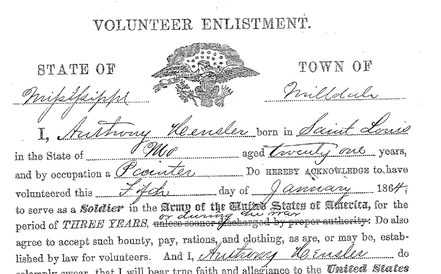 According to his enlistment papers in the U.S. Army, he was 21 years of age on January 5, 1864. And, in an affidavit in his wife’s pension records, it is stated that he was 18 years old when he enlisted (in 1861). His parents were married in 1850. Wait. 1850?! Now I’m confused. Which is correct - Anthony was born between 1843 and 1846 (before his parents were married) or was he born later? Or perhaps the date of his parent’s marriage is incorrect. Let’s explore each possibility separately. The marriage of Valentine Hensler and Theresa Fay is recorded in both the pension records for Valentine, as well as in the church records in St. Louis, where the marriage took place. The date, January 22, 1850, is the same in both documents. One is an indirect record and the other a direct one, filed one month after the event. Given these pieces of evidence, there is little doubt of the accuracy of this date. Next, let’s consider the possibility that Anthony was born later than 1846, after his parents were married. To explore this, we look to his enlistment papers in 1861. If he was born after the marriage of Valentine and Theresa in 1850, he would have been barely 11 years old at the time of enlistment. While there were certainly young men who entered the Army during the Civil War, 11 is exceptionally young. What is more, his younger brother, Valentine, appears to have been born in 1850. This leaves us to conclude that Anthony was born out of wedlock to Valentine and Theresa. (Heaven’s no!) But wait, there is another possibility. Anthony’s alias is Arthur Fay, the maiden name of Theresa. With this information, perhaps we should consider the notion that Anthony (or Arthur) is not the son of Valentine Hensler. Dun dun dun. Let’s leave the question of his birthdate for a moment and examine his military record. Was he truly a prisoner at Andersonville, one of the most infamous prisons in U.S. history? A prisoner of war According to his military record, Anthony Hensler enlisted with the 53rd Regiment of Army Volunteers in Ottawa, Illinois on December 15, 1861. With the exception of a thirty-day furlough in October of 1863, he was consistently present for muster rolls every month for two years. During this time, his regiment traveled hundreds of miles from Illinois to Tennessee, Mississippi, and Georgia, and fought in numerous campaigns. In October of 1862, Anthony was wounded at the Battle of Hatchie in Hardeman County and McNairy County, Tennessee. In January of 1864, he reenlisted while in Mississippi. Again, Anthony is continuously present in the muster rolls, until July of that year, when: 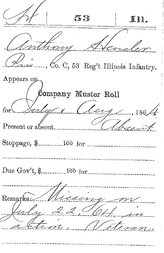 Anthony Hensler is listed as "missing" from July 22, 1864 through February, 1865 - that is nearly 7 months. Then, in the March/April 1865 muster roll, the record notation is revised to show that he was “taken prisoner” at Atlanta, Georgia. And finally, in the last pages of his military record, there is a Memorandum From Prisoner of War Records. This document confirms his capture and imprisonment at Andersonville. What is more, earlier this year, I visited the National Historic Site, and discovered his name among the records there. A chilling discovery. In fact, Anthony Hensler was a prisoner at Andersonville Prison for at least 9 months - an abhorrent experience that I cannot put into words. Rather, I will share an excerpt from the memoirs of another survivor of that wretched place (warning: this is a graphic depiction): "...a surgeon reports that in August and September there were more than 3000 sick lying on the bare ground partially naked; some had broken limbs, some were gangrened, some suffering with scurvy, some with chronic diarrhea...Lice, fleas, and incredible clouds of mosquitoes deprived them of sleep, and drove them mad...Many voluntarily crossed the dead line in order to be shot. Attracted by the smell of this living carrion, flocks of vultures, the "turkey buzzard" of the South, soared high in the air over this den of human putridity...If your readers are shocked...let me assure them that I have not told half of the reality." Despite this troublesome discovery about my great-great grand uncle, the research continued. There were still more questions to be answered, particularly regarding his wife, Cinderella and his life after the war. I will share the answers to these remaining questions in the next and final post on Anthony's life.
0 Comments
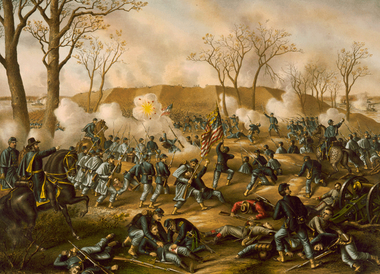 "Battle of Fort Donelson" by Kurz and Allison (1887). "Battle of Fort Donelson" by Kurz and Allison (1887). When researching family history, with all of the verification and double documentation that it entails, discovery of a misspelling or error in a name is common. At times, it can frustrate efforts to confirm the identity of an ancestor. In fact, rarely does an error in a name represent anything other than an obstacle - unless it is an alias. Then, it is something else altogether. The search becomes a quest, the question becomes a mystery and the excitement of solving the enigma builds and builds. This is where I will begin my blog - with a 19th century ancestor whose very name elicits mystery - an ancestor with an alias. Valentine, the father Valentine Hensler, my 3rd great-grandfather was a German immigrant, husband and father to 10 children. For many years, he supported his large family as a humble carpenter in the town of Ottawa, Illinois. On August 15, 1861, Valentine's life started down a new, transformational path: he enlisted in the United States Army. In the following 17 years that remained of his life, this decision would resonate with all of the destruction and anguish that war inevitably brings. From 1861 to 1864, Valentine served in the 11th Illinois Volunteer Infantry, a regiment that engaged in numerous battles and lost 471 men. One such battle was fought at Fort Donelson, Tennessee, a battle which - if you were a sharp, ambitious Brigadier General named U.S. Grant - you might say was pivotal or, perhaps, resulted in "unconditional surrender." On the other hand, if you were a 30-something private with a family waiting at home, the 6-day assault in which more than 800 men were killed (and 14,000 more missing and captured), might instead be remembered as bloody chaos, one of many memories only to be drowned out by alcohol and depression later in life. In fact, my 3rd great-grandfather, Valentine Hensler, was "broken down very much by the 3 months and 3 years service" and lived his final (likely wretched) days in the LaSalle County Asylum and Poor Farm - a place described by state reviewers in 1881 as "horrible" and "inexpressibly disgusting." He died there in August of 1878, of cirrhosis. Of course, it is impossible to know the true details of his existence; however, my investigative skills (and simple human, empathic sense) tell me that this veteran - this industrious family man, born in Germany and immigrant to the land of opportunity - suffered more than my words can describe. And unfortunately, the suffering was not his alone. In addition to the torment most assuredly endured by his family and friends - as it turns out - the war entrapped not one but two Hensler men. Anthony - or is it Arthur? What I know of Valentine I learned from census records, passenger manifests, county historical documents and Civil War military indices - weeks of research to piece together years of his life. However, it was not until I acquired Valentine's complete pension record that I discovered a mystery that would take months to unravel. More than 10 pages deep into the 150-year old scrawl, I found a statement from Valentine's widow, Theresa Fay. (The pension record is comprised of pages and pages of records that document Theresa's efforts to prove her eligibility for her late husband's pension). In this notarized statement, it is noted that "the parents also had a son 15 years of age who was admitted in the service and continued three years and was a prisoner at Andersonville and contracted consumption and died 14 months after discharge..." Could this be? A prisoner of Andersonville? How much could this family possibly have suffered? The only child of Valentine and Theresa that would fit that description (male, age 15 around 1861) would be Anthony - the oldest child, about whom I had not discovered much of anything. Immediately, I began to focus my research on Anthony, looking for any indication of military service and scanning census records for his whereabouts. Then, I found this: A U.S. Civil War pension index record in the name of Arthur Fay (alias Anthony Hensler). Now, Fay was Anthony's mother's maiden name. That couldn't be a coincidence. And, Cinderella?! That must be someone in my family. Only several more weeks of research (including more than a 100 pages of documents and a trip to Georgia) would reveal the truth.
|
AuthorLisa Medina, here to share the history of families - one story at a time. . Archives
May 2016
Categories
All
Copyright © 2020-2021 Lisa Medina Genealogist & Family Historian
|

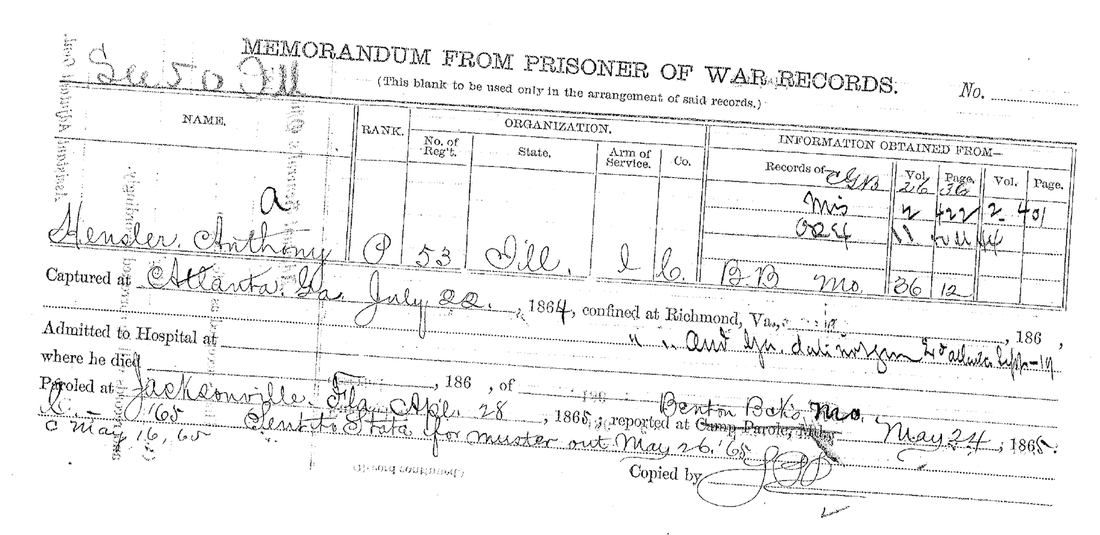
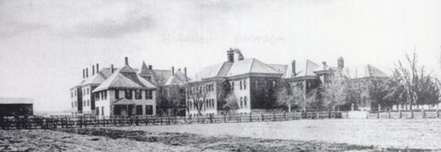


 RSS Feed
RSS Feed
